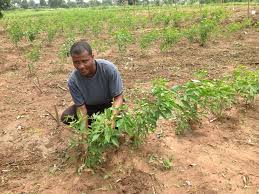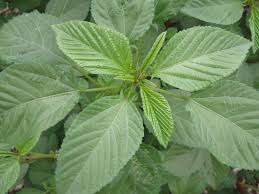Yam Tendrils: Economic Importance, Uses and By-Products
Yam tendrils generally refer to the young, tender shoots or vines that emerge from the yam plant as it grows. Yams are starchy tuber vegetables that belong to the Dioscorea genus. They are commonly grown in tropical and subtropical regions for their edible tubers.
Yam tendrils are the thin, climbing stems that emerge from the yam plant’s main tuber or underground storage organ. These tendrils are used for climbing and attaching the plant to a support structure, like a trellis or another plant. They play an important role in the yam plant’s growth and reproduction by allowing it to reach sunlight and spread out to find support.
In some cultures, yam tendrils are also harvested and used as a vegetable. They are tender and have a mild flavor, somewhat similar to spinach or other leafy greens. Yam tendrils can be used in salads, stir-fries, soups, and other dishes. They provide a nutritious addition to the diet, as they are a source of vitamins, minerals, and dietary fiber.
It’s important to note that not all yam species produce tendrils that are suitable for consumption. Some yam species have tendrils that are toxic or inedible. If you’re interested in trying yam tendrils as a food source, it’s best to consult with local experts or reliable sources to ensure that you’re using the right type of yam and preparing it safely.
The Economic Importance and Uses of Yam Tendrils

Yam tendrils, also known as yam vines or yam leaves, refer to the climbing or trailing parts of yam plants (Dioscorea species) that grow along with the yam tubers. These tendrils have several economic importance and uses, particularly in certain cultures and regions. It’s important to note that the economic significance and uses of yam tendrils can vary based on local customs, traditions, and practices.
Here are some of the potential economic importance and uses of yam tendrils:
1. Food Source: In many cultures, yam tendrils are edible and are used as a leafy vegetable. They are rich in nutrients such as vitamins (A, C, and B-complex), minerals (iron, calcium, and potassium), and dietary fiber. They can be prepared and consumed in various ways, such as stir-frying, sautéing, or adding to soups and stews.
2. Culinary Uses: Yam tendrils can add a unique flavor and texture to dishes. They are often used in traditional recipes and cuisines to create flavorful and nutritious meals. Incorporating yam tendrils into the diet can contribute to diversifying the range of available food sources.
3. Income Generation: Cultivating and selling yam tendrils can provide an additional source of income for farmers and local communities. The demand for these edible greens can create opportunities for small-scale agriculture and entrepreneurship.
4. Traditional Medicine: In some traditional medicine practices, yam tendrils are believed to possess medicinal properties. They may be used to treat certain ailments or conditions. However, it’s important to note that scientific research is needed to validate any potential medicinal uses.
5. Livestock Feed: Yam tendrils can be used as fodder for livestock, including cattle, goats, and pigs. This can be especially important in regions where animal husbandry is a significant economic activity.
6. Biodiversity and Crop Rotation: Incorporating yam plants, including the tendrils, into agricultural systems can contribute to crop rotation and diversification. This can help improve soil health, reduce the risk of pests and diseases, and enhance overall farm sustainability.
7. Nutrient Cycling: The use of yam tendrils as livestock feed or green manure can contribute to nutrient cycling within agricultural systems. When the plant material is returned to the soil, it can enrich the soil’s organic matter content and nutrient levels.
8. Cultural and Traditional Uses: In some cultures, yam tendrils hold cultural and traditional significance. They might be used in special dishes prepared during festivals, ceremonies, or other cultural events.
9. Research and Development: Yam tendrils, along with other parts of the yam plant, can be studied for their nutritional content, potential health benefits, and other properties. This research can lead to the development of value-added products, such as nutritional supplements or functional foods.
10. Sustainable Agriculture: Yam plants, including their tendrils, can play a role in sustainable agriculture practices. These plants have the ability to fix nitrogen in the soil through their symbiotic relationship with nitrogen-fixing bacteria. This can reduce the need for synthetic fertilizers and contribute to soil fertility.
Read Also: Yam Inflorescence: Economic Importance, Uses and By-Products
11. Crop Diversification: Including yam plants and tendrils in crop rotations can help diversify farming systems, which can be important for risk management and resilience. Crop diversification can also lead to increased income stability for farmers.
12. Local Food Security: Yam tendrils can contribute to local food security by providing an additional source of nutritious food. This can be especially important in areas where access to a diverse range of vegetables is limited.
13. Export and International Trade: In regions where yam tendrils are grown in abundance and are popular as a food source, there might be potential for export to markets where they are less readily available. This could generate economic opportunities for producers.
14. Community-Based Initiatives: The cultivation and utilization of yam tendrils can foster community-based initiatives focused on sustainable agriculture, nutrition, and economic development. This can lead to stronger community ties and cooperation.
15. Beverage Production: In some cultures, yam tendrils are used to prepare traditional beverages, often through fermentation. These beverages may hold cultural significance and be enjoyed during special occasions.
16. Horticultural Interest: Yam tendrils can also be cultivated for ornamental purposes. Their vining and trailing growth habit can be visually appealing, making them suitable for garden and landscape design.
17. Research and Culinary Innovation: As interest in traditional and regional cuisines grows, researchers and chefs may explore the culinary potential of yam tendrils. This can lead to innovative recipes and dishes that contribute to the culinary diversity of different cuisines.
18. Agroforestry Systems: Yam plants, including the tendrils, can be integrated into agroforestry systems. This approach combines agricultural crops with trees, promoting biodiversity, soil conservation, and sustainable land use.
19. Home Gardening: Home gardeners can grow yam plants, including the tendrils, to supplement their own food supply. This can be a cost-effective way to access fresh, nutritious greens.
20. Climate Resilience: Yam plants are relatively resilient to various environmental conditions, including drought. Incorporating yam plants and tendrils into farming systems can contribute to climate-resilient agriculture.
The Products and By-products That Can Be Derived From Yam Tendrils
Yam tendrils, also known as yam shoots or yam leaves, are young, tender shoots and leaves that emerge from the yam plant. These tendrils are edible and have culinary uses in various cuisines.
Here’s a list of products and by-products that can be derived from yam tendrils along with explanations:
1. Edible Greens: The primary product derived from yam tendrils is the tender shoots and leaves themselves. These are harvested and used as a nutritious vegetable in cooking. They are commonly consumed in Asian and African cuisines and can be prepared in various dishes such as stir-fries, soups, stews, and salads.
2. Leafy Vegetables: Yam tendrils are rich in vitamins, minerals, and dietary fiber. They can be treated as leafy greens, similar to spinach or kale, and used to add nutrients and flavor to meals.
3. Stir-Fries and Sautéed Dishes: Yam tendrils are often stir-fried or sautéed with other vegetables, meats, or seafood. They can be seasoned with herbs, spices, and sauces to create flavorful dishes.
4. Soups and Stews: Yam tendrils can be added to soups and stews to enhance their nutritional content and provide a unique taste and texture.
5. Salads: Tender yam shoots and leaves can be used as a base or an ingredient in salads, providing a refreshing and nutritious component.
6. Side Dishes: Yam tendrils can be prepared as standalone side dishes by cooking them with seasonings, garlic, and other complementary ingredients.
Read Also: 10 Medicinal Health Benefits of Senegalia polyacantha (Senegal Wattle)
7. Smoothies and Juices: Yam tendrils can be blended into smoothies or juiced to create nutrient-rich beverages. They can be combined with fruits, vegetables, and liquids for a refreshing drink.
8. Powdered Form: Yam tendrils can be dried and ground into a powdered form. This powder can be added to various foods and beverages to enhance their nutritional content.
9. Medicinal Uses: Some traditional medicine practices use yam tendrils for their potential health benefits, such as being a source of antioxidants and having anti-inflammatory properties.
10. Animal Feed: In some cases, yam tendrils that are not suitable for human consumption due to their quality or quantity may be used as feed for livestock.
11. Compost and Organic Matter: If yam tendrils are not consumed or utilized, they can be composted to enrich soil with organic matter and nutrients.
It is important to note that the culinary and nutritional uses of yam tendrils can vary across different cultures and regions. Additionally, proper harvesting practices and food safety considerations should be followed when collecting and preparing yam tendrils for consumption. Always ensure that yam tendrils are harvested from safe sources and properly prepared before consumption.
In conclusion, it is important to emphasize that the economic importance and uses of yam tendrils can vary based on regional preferences, agricultural practices, and cultural factors.
Read Also: Economic Importance of Fish and Fish Products









